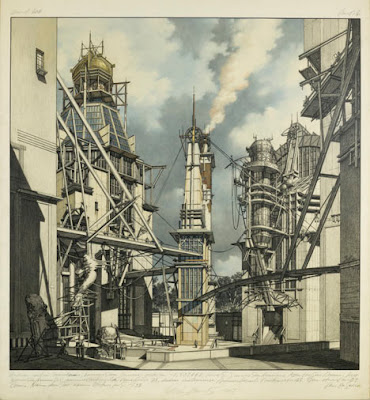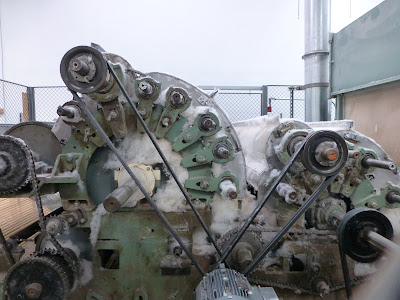I recently had the opportunity to attend the latest show at the San Francisco Museum of Modern Art, featuring the stunning drawings of Lebbeus Woods. I'm not going to attempt to write a philosophical or critical analysis here, just give you my impressions, along with images that I got of the internet of some of his drawings (hoping that's all legal, of course!)
Reading the information at the show, and doing a bit of follow up research, I can report that Mr. Woods studied architecture at Purdue and University of Illinois, but never got his license to be a registered architect. After school, he worked in the office of Eero Saarinen, best known for designing Dulles Airport and the TWA terminal in New York. He was a professor of architecture at the Cooper Union in New York, and taught and lectured around the world. I remember seeing and being awed by some of his drawings while I was in architecture school myself.
He has very little built work, and what I've seen of it in pictures, honestly, doesn't live up to the promise of his drawings. But his drawings are just amazing, and these are the main focus of the exhibit, along with some models that were built by collaborators, based on his designs. There's also a short film that shows Woods and Steven Holl discussing a collaboration they did on a project in China, that frankly, got boring after a while.
When I looked at the pictures in the show, I felt most fit into two categories - inventions and interventions. The first group created fantastic imaginary worlds, filled sometimes with gothic looking cities and structures, and other times with vividly created futuristic environments.
The interventions placed his fantastic structures into existing environments after disasters, like Sarajevo after the war, and San Francisco after the earthquake. Here, Woods' unique structures are offset by the existing buildings and landforms, and in some of the SF studies, the ocean.
All of the drawings are amazing, both for their remarkable imagination, and their impeccable craftsmanship. It's rare to see such intricate pencil work, with subtle shadings and layer upon layer of delicate lines. I was drawn in to look closer and closer, which was tricky given that i'd just come from the eye doctor, and was still somewhat dilated!
In looking at the drawings, I couldn't help but feel that I'd experienced some of the places before, and I realized that they reminded me a lot of the computer generated fantasy or futurist cities that have been so prevalent in movies. On looking this up, I found that his work was in fact the inspiration for the sets in the movie 12 Monkeys with Bruce Willis, and he sued the filmmakers, receiving a large settlement, and credit for his inspiration in the titles. He also inspired the design for the memorably gross Aliens 3.
But I see his influence in even more films, like Lord of the Rings, Brazil, Jack the Giant Slayer (which I am embarrassed to say I both saw and enjoyed), the new Wizard of Oz, and all of the Star Wars films. But again, I would say that the drawings are even more compelling than the inspired realistic urban visions in all of these films.
I would encourage anyone who has the opportunity to visit and take the time to really enjoy this show. I know I'll be going back to be transported into his mystical worlds again myself.
























